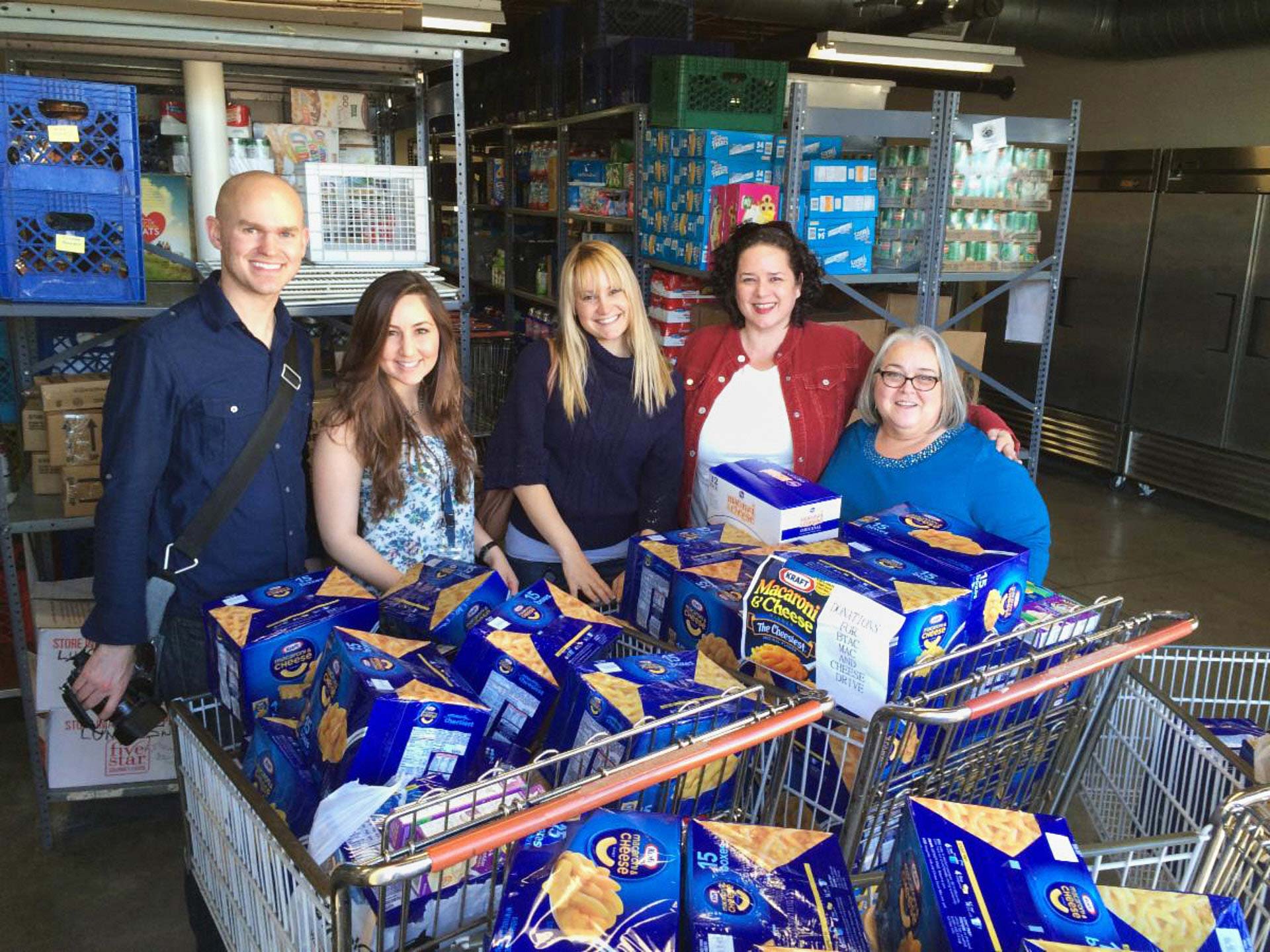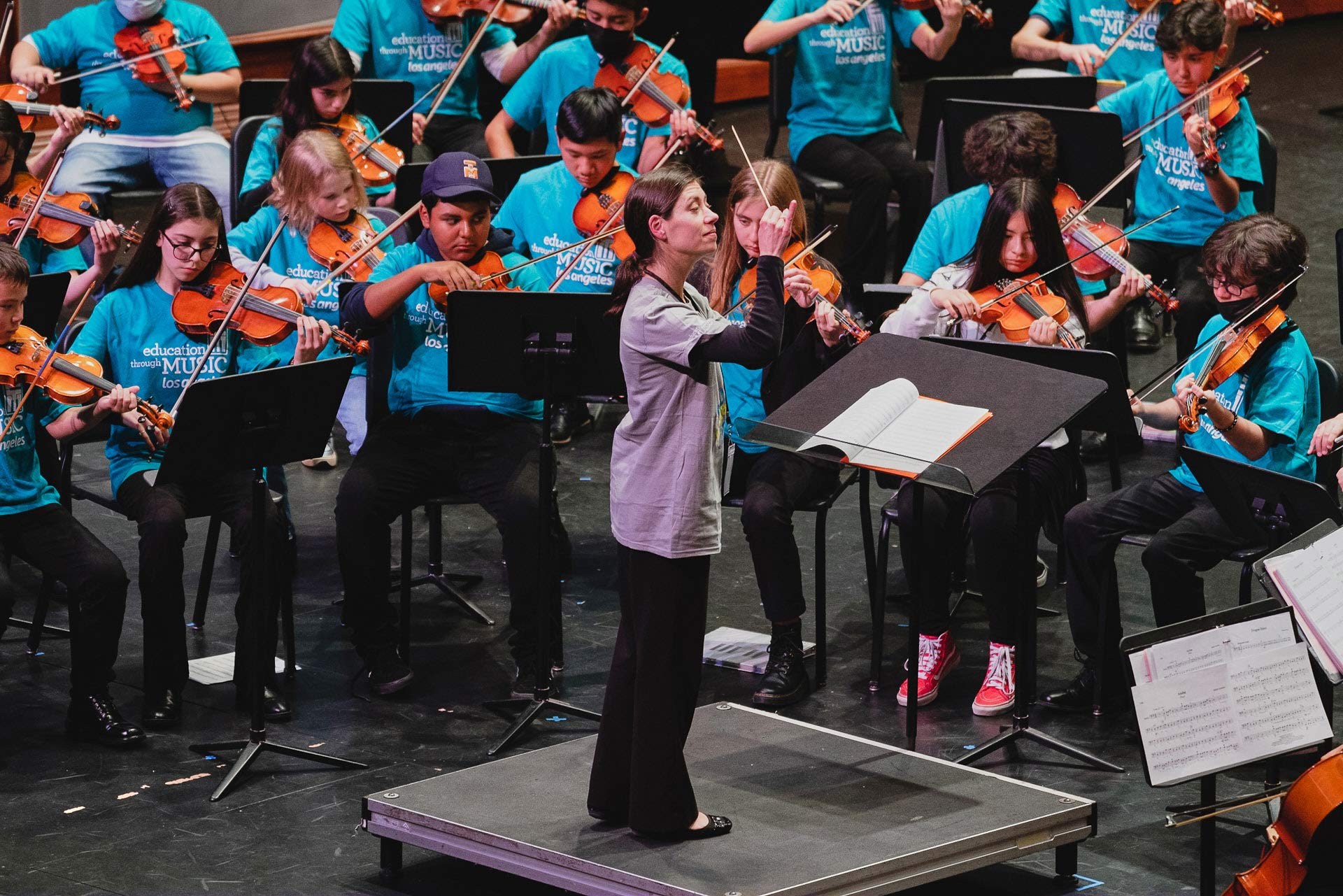
The spirit of kindness and generosity extends far beyond the holiday season for the many local organizations and volunteers dedicated to supporting the well-being of our community’s most vulnerable neighbors. The nonprofits spotlighted here are among those working year-round to provide enriching opportunities and critical resources for those who need them most.

Education Through Music–Los Angeles
When Juilliard-trained violinist Victoria Lanier arrived in L.A. nearly two decades ago, she noticed something missing from many local classrooms — music. Having worked with the original Education Through Music program in New York, she decided to bring the model out west. In 2006, she founded Education Through Music–Los Angeles (ETM-LA) to make music a core part of every child’s school day, no matter their ZIP code or family income.
What began with two partner schools serving about 800 children has since grown into a thriving countywide network.
“We have 42 partner schools reaching approximately 18,000 children (ages 4–14) with sequential, comprehensive yearlong music education at no cost to students,” Lanier shares. “We work across Los Angeles County in underresourced communities, including Bellflower, Boyle Heights, Burbank, Compton, Chinatown, Downtown L.A., East L.A., Elysian Heights, Inglewood, Pacoima, San Fernando Valley and South Central.”

ETM-LA’s mission is to provide and promote music as part of the core curriculum in underserved schools, nurturing students’ academic achievement, creativity and overall well-being. By partnering with elementary and middle schools, ETM-LA brings high-quality, sequential, culturally responsive music education for all students, regardless of background or ability. Lanier says, “Learning music is a means for self-expression, finding your voice and an outlet to help cope with difficult situations. For students from underresourced communities, music provides them hope.”
To date, more than 150,000 students have been impacted through ETM-LA’s programs. “It is truly the collective hands, hearts and minds of our dedicated ETM-LA family and communities that have brought us to this point,” Lanier notes. “We stand hopeful that our impact and the transformative benefits of learning music will be amplified for generations to come.”
ETM-LA’s approach is built on partnership and long-term sustainability. The organization works alongside schools and districts in marginalized areas, helping them go from little or no music programming to developing vibrant, schoolwide programs that last.
“We integrate general music during the school day as part of the core curriculum for every student in the school. Students are able to build musical skills and concepts, and receive ukulele, recorder, percussion, music technology and vocal instruction,” Lanier explains. “We also customize after-school programming, including strings orchestra, band, modern band, Orff ensemble, songwriting and choir — helping students deepen their skills and providing more performance opportunities.”

Students perform twice a year at winter and spring concerts, showcasing what they’ve learned to their families and communities. “We hope students gain a solid foundation in musical learning while making sense of the world, integrating and making connections to other areas of their life,” Lanier says. “We hope that through music, students develop a greater sense of self — and lead with empathy for others.”
Over the years, ETM-LA’s programs have earned widespread recognition. More than six partner schools have received California Distinguished Schools for the Arts awards, and the organization has been honored by the American String Teachers Association, Los Angeles Business Journal, The Music Man Foundation’s Meredith Willson Awards and the LA2050 Grants Challenge.
Actor and musician Ed Helms, who serves on ETM-LA’s advisory board, has been a longtime supporter of the nonprofit’s mission. “The gap in education opportunities in different communities is one of the great social injustices, and Education Through Music–LA plugs right into that in a very smart and critical way,” Helms shares. “Music has impact — and ETM-LA is a force-multiplier for that impact.”
While ETM-LA has achieved remarkable growth, the organization continues to face systemic challenges — particularly a shortage of qualified music teachers. Although Proposition 28 provided the first increase in California public school arts funding in over three decades, thousands of additional arts teachers are still needed statewide to meet growing demand.
To help bridge that gap, ETM-LA offers a music teacher internship and workforce development program to prepare the next generation of educators. “We’re working to provide career pathways for college students, most especially those who may not typically have opportunities to enter the teaching field,” Lanier explains.

Throughout the year, ETM-LA hosts a range of community events that bring its mission to life. Highlights include the Music Unites the World Festival each March, which features a songwriting and composition contest open to the public, as well as summer music programs, teacher training academies and the annual benefit gala.
For nearly a decade, ETM-LA has partnered with Toluca Lake Elementary School, offering weekly, yearlong music instruction and after-school choir opportunities for students in the community. The program has been met with tremendous enthusiasm from local families and educators.
Principal Jeffrey Daniel says the school’s music teacher, Terri Walsh, has become an integral part of students’ lives. “Our school has an annual Move-a-Thon fundraiser led by our dedicated PTA that raises the majority of the funds to pay for the ETM-LA music program,” he explains. “We’ve been incredibly fortunate to have Mrs. Walsh as our music teacher for the past eight years. She is truly exceptional — her passion for music and teaching shines through in every class. Our students absolutely adore her and look forward to music class each week with great excitement.”
As ETM-LA celebrates its 20th anniversary, the organization’s vision remains clear: to ensure that every child in L.A. has the opportunity to learn, perform and grow through music. “Everyone should care about music education as it impacts children and their development today and into the future,” Lanier says.
An ETM-LA student graduate shared, “For some students, music can mean the difference between staying engaged in school or not. All children want is a chance — if we teach them at a young age that they can do big things no matter the circumstances they’re in, they can save the world.”
To learn more about Education Through Music–Los Angeles, please visit etmla.org.

Taking the Reins
Tucked away in Atwater Village’s historic equestrian district along the L.A. River lies an urban farm that’s home to Taking the Reins (TTR), a nonprofit helping underserved girls across L.A. navigate personal growth through a comprehensive equestrian, animal husbandry and gardening program. Its mission is to “advance girl power through horsepower” by cultivating a safe, nurturing environment that encourages youth to act boldly with courage and confidence.
Recognizing the many physical, mental and emotional benefits that riding and caring for horses could offer the city’s youth, founders and avid horsewomen Debra Avery and Judith Hopkins established TTR in 1998 as an after-school horseback riding program for girls from low-income families and Title I schools. They began offering lessons at the Paddock Riding Club in Atwater Village with five horses and a converted stall that served as a classroom, and the program took off from there.
In 2018, under the leadership of executive director Dr. Jane Haven, TTR completed the purchase of its own 1.5-acre facility, located adjacent to Griffith Park and along the east side of the L.A. River. Today, TTR features a state-of-the-art equestrian center, complete with a barn, youth education center and a garden with a teaching and food-preparation kitchen.
Over the past 27 years, TTR’s urban farm has grown into a year-round equestrian, environmental science and nature program, as well as a seed-to-skillet garden and nutrition program. “We provide a safe place for over 400 L.A. youth per year to call their ‘second home,’” Haven says. “From kids in foster care to children dealing with the loss of a parent, girls on the autism spectrum and the numbers of girls who just want a horse and a community of friends to share a passion for nature with, we have a fun and educational farm for all types of girls!”

The organization has served more than 6,000 girls since its inception. “Many youths start our program around age 8 and about a quarter of the students stay through the end of high school,” Haven adds.
TTR offers after-school and weekend programs, as well as summer sessions, workshops and holiday camps. Its core programming serves girls ages 11 to 18 and consists of three essential components. (TTR’s Cowgirl Corner program for girls ages 8 to 11 offers a “pony-sized” version of the experience.)
The equestrian component teaches students how to responsibly care for the horses and facilities. Through the introductory course, they learn grooming, nutrition, tacking, the importance of bonding and more. As their skills progress, students can take part in basic Western riding lessons, join the Show Team, take hippology (the study of horses) classes and participate on the Judging Team, which travels to horse shows to learn about different breeds. “Horses provide feedback to the student that fosters awareness of nonverbal communication and helps the student develop boundaries and focus,” Haven notes. “When you are a clear leader, your horse responds in a way that encourages leadership.”
The seed-to-skillet gardening program teaches girls about healthy eating, nutrition, environmental stewardship and how to cook what they grow in TTR’s garden. They plant seeds and seedlings, nurture and protect their growth, harvest the fruits of their labor and learn to prepare their produce through basic cooking classes held in the organization’s nicely equipped kitchen trailer overlooking the garden and riding arena.
Rounding out the curriculum is the animal husbandry program, which teaches girls how to care for the sheep, chickens, tortoises, ponies and cats that live on the property.
In addition to outdoor activities, TTR offers traditional educational programming at its Learning Center, where science, technology, engineering, arts and mathematics (STEAM)–based classes, tutoring and workshops are available.
“Many people think we are a therapy program. There is certainly a therapeutic value to working with animals and being in nature; however, we are a STEAM–based education and youth development program that uses animal science and the natural environment to teach urban girls leadership, teamwork, self-confidence and responsibility while working with horses and our farm animals,” Haven explains. “With our education program and tutoring services, as well as our Junior Board and workforce initiatives, students receive support in achieving their academic, social–emotional and fitness goals, all while participating on our urban farm and learning the lessons best taught by a horse.”

TTR’s programs are open to all girls in L.A. who want to participate. “No child is unable to attend due to lack of funds,” Haven says. “We meet with families and youth and share our program so they can see if it is a good fit.” The organization operates on a sliding fee scale, allocating part of its budget to provide financial assistance to qualified participants. Any additional funding comes from corporate and individual donors, which Haven notes can be challenging to secure. One of TTR’s main sources of support is its annual Denim and Diamonds fundraiser, which generates more than $60,000 to cover program expenses.
“Fifty percent of our funding is provided by individual donations — many from out of state, surprisingly. We also write many grants to foundations and seek support from corporate donors,” Haven shares. “As a nonprofit, building community and securing donors is a full-time job. Over 75% of our students come from underresourced areas of L.A. … Many are here on full-tuition support provided by our donations.”
The funding TTR has received over the years has helped secure its future by enabling the organization to own its facility and develop an affordable model built on quality lesson horses and a robust, diverse program. “With the addition of our post-high school Youth Empowered for Success (YES) program, we have provided $193,000 in college scholarships to qualified students who have committed to TTR’s programs,” Haven says.
This past summer, TTR expanded its programs to serve boys ages 6 to 9 and will launch an environmental science workshop series this winter. Boys and girls from community nonprofits, public schools and private schools are invited to enroll in two to three workshops focused on the L.A. River and local water systems, native plants and the early history of the L.A. Basin, and animal habitats and bird migration patterns in the Griffith Park area. The final workshop will include a horseback ride along the park’s 50-mile trail system, where students will identify native plants and experience nature in a hands-on way. TTR is currently seeking funding to grow this program in the future. “Our environmental science program will allow 200 to 300 more students per year to have an immersive experience in nature with top educators in the earth sciences,” Haven shares.
To learn more about Taking the Reins, please visit takingthereins.org.
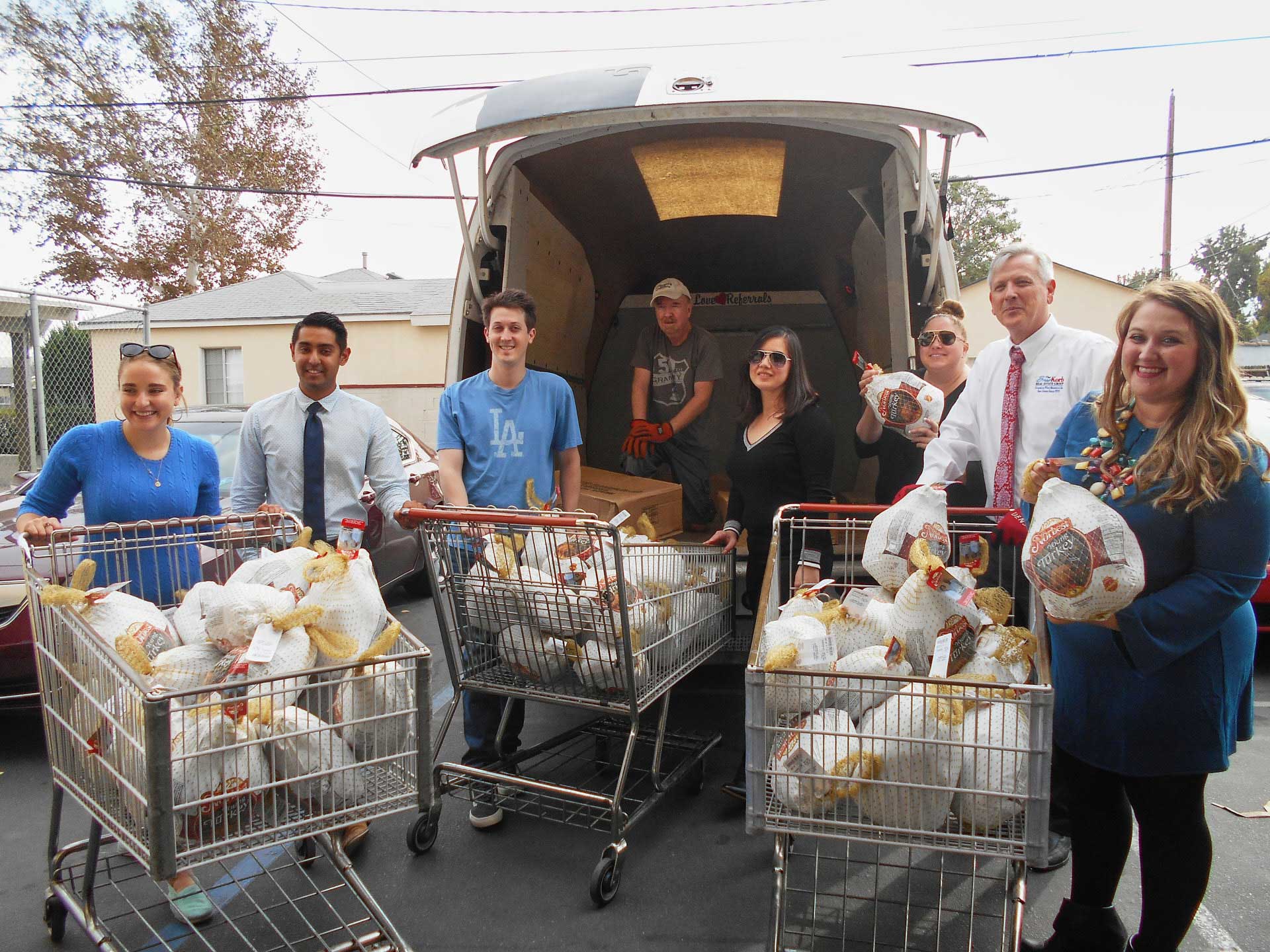
Burbank Temporary Aid Center
“Beautiful downtown Burbank” and its surrounding areas are famous for their combination of entertainment-industry glamour and quiet residential charm. In the popular imagination, it’s an idyllic place far removed from the difficulties faced by more urban, less prosperous areas. “Many people don’t realize that Burbank has a fairly significant working poor population,” Burbank Temporary Aid Center (BTAC) executive director Barbara Howell says. “We see the houses on the hills, in the Rancho and in Toluca Lake, the multiple studios, etc., and don’t consider that there might be households that are struggling.”
It was to address those hidden struggles that BTAC was founded in 1974 with the mission of providing a centralized means to help meet short-term needs for food and basic services for the community’s low-income individuals and families. The organization began by giving away food and clothing to local residents. Although the clothing program was eventually discontinued and other services have since been added, the core principle remains the same today. “BTAC is primarily a food pantry,” Howell explains. “Over 80% of those we serve are actually housed residents of Burbank.” In addition to a variety of grocery, personal hygiene and household items, clients can access free laundry services. BTAC also administers Burbank Water and Power’s low-income assistance program, Project Share, which helps residents with a credit toward their utility bill.
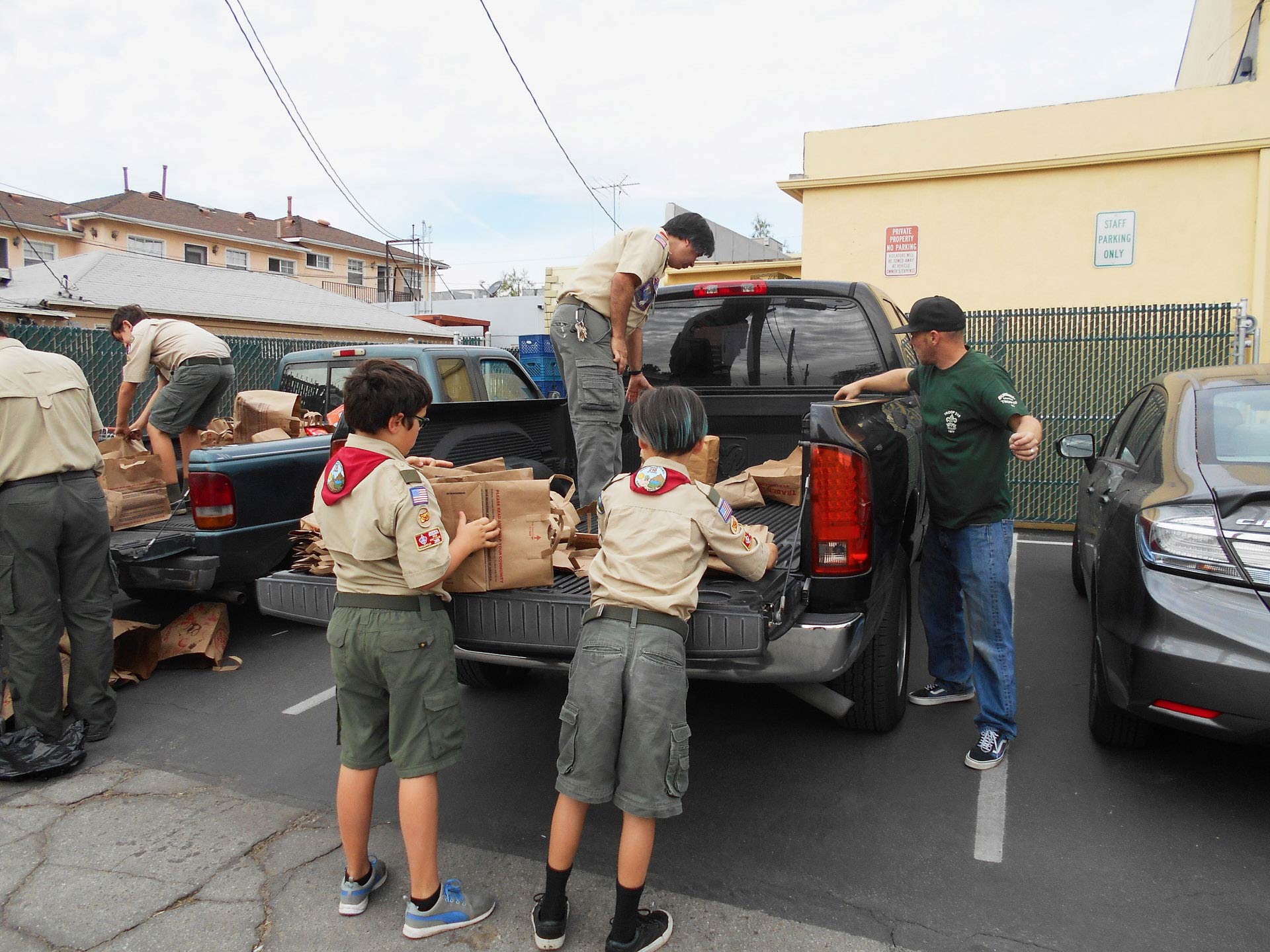
Along the way, BTAC also began offering services to homeless clients — not only access to the food pantry and laundry services, but also sack lunches and shower facilities. “BTAC is unlike any other organization of which I am aware,” Howell notes. “We are a hybrid, helping both housed and unhoused.”
In its early years, BTAC was volunteer-run and operated out of a number of different buildings around Burbank. As it grew, paid staff were slowly added, and in 1995 the organization settled into its current location on Burbank Boulevard, in a commercial storefront with a residence behind it that was converted to office space. Over the past 20 years, BTAC has successfully completed two capital campaigns to improve the facility. In 2005, what Howell calls the “sad little office and house” was renovated, and the facility then expanded to include the space next door, allowing it to provide more services to more people.
Like many other nonprofits, BTAC encountered obstacles during the COVID pandemic. Its staff of six full-time equivalents (FTEs) and volunteer workforce of more than 80 dropped to four FTEs and 18 volunteers. Fortunately, the volunteer count slowly started growing back, and there are currently about 40 to 45 people scheduled for one to three four-hour shifts each week. The organization still faces ongoing hurdles, including being required to comply with organics recycling requirements and to maintain L.A. County Health Department standards such as daily trash pickup, cleaning, correct hot water temperature, and commercial refrigerators and freezers. “It is a challenge, because we are graded the same way as a grocery store, but without the same resources,” Howell says. “That’s what makes me so proud of our A rating, which we have had since 2006.” The additional processes and expense of meeting such requirements, combined with the cost of operations and maintaining the property — the leaking roof was finally fixed this year, and the monthly power bill is nearly $3,000 — means that “funding is always an issue and always will be,” Howell adds.
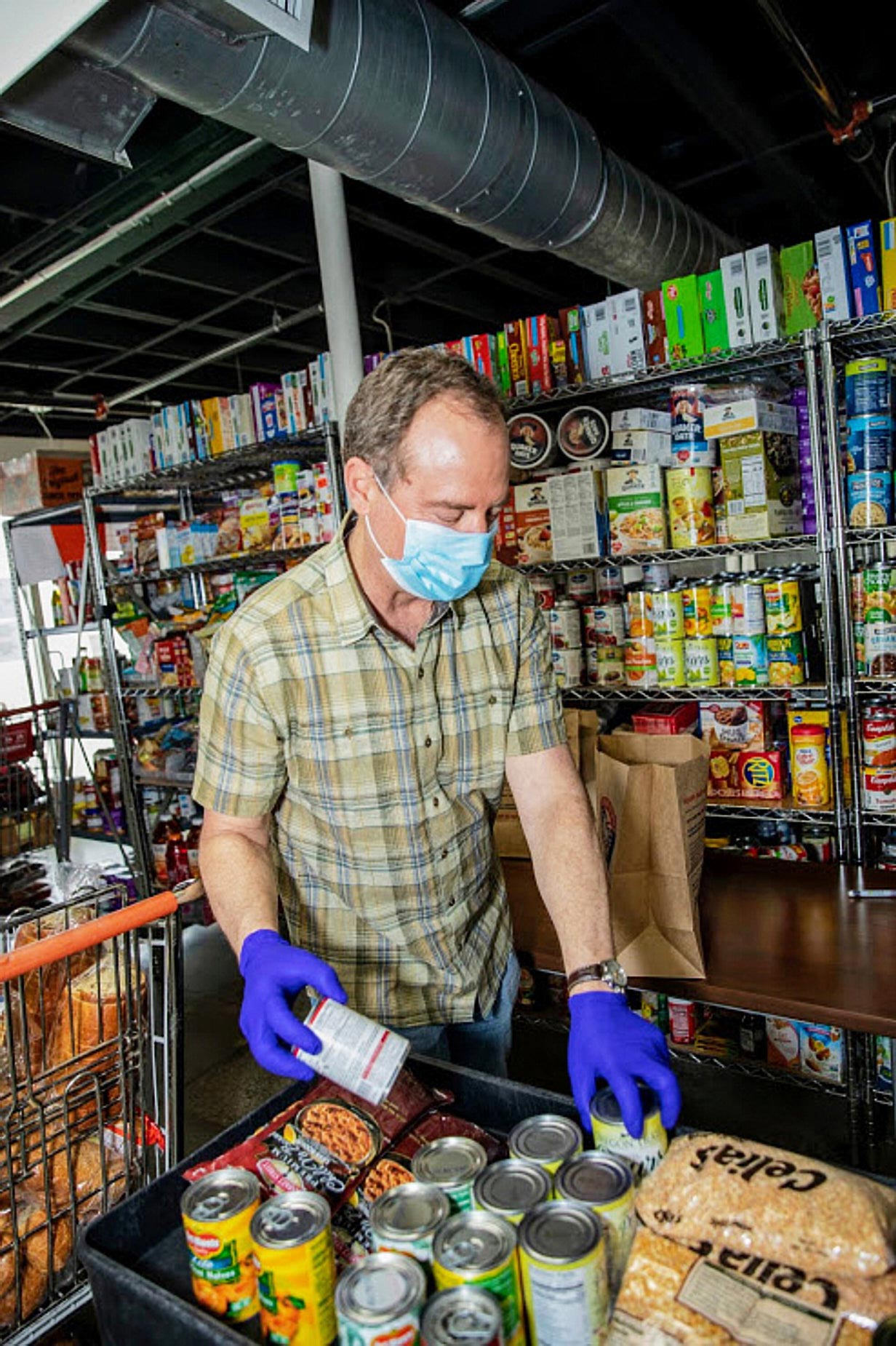
Despite difficulties, BTAC has thrived through dedication and ingenuity. “We can’t do everything for everyone, so we want to do what we do in the very best way possible,” Howell declares. In addition to expanding programs over the years, BTAC’s leadership has put best practices in place to ensure the organization’s viability and transparency. They’ve also worked to diversify income sources to ensure that the charity can still survive if one is lost. And, of course, community participation is key — not only from the vital volunteers who coordinate client services or work in the pantry sorting and packaging food items, but also from the individuals, clubs, organizations and businesses that donate groceries to stock the shelves. “We have great relationships with local grocers, so we’ve been able to add fresh produce, dairy and even meats to the foods we distribute,” Howell says. BTAC accepts donations of full-size and travel-size hygiene items as well — and, of course, the crucial financial gifts that enable it to keep its doors open.
The need is especially great during the upcoming holiday season, the organization’s busiest time and one that is especially critical this year. “Due to uncertainties in our nation and economy, donations of both funds and food have dropped off,” Howell says. “We need the community to be as generous as possible to ensure BTAC can provide the groceries, including holiday foods like turkeys, stuffing, etc., for marginalized households. We depend on the generosity of the holiday season to help carry us, both with food and financially, through the first few months of the year.”
This season is also one of change for Howell, as she prepares to retire after more than two decades at BTAC’s helm. After a 2002 midlife crisis inspired a job transition, she brought her expertise from working with major nonprofits like Easter Seals and the Leukemia and Lymphoma Society to the smaller scale of a local food pantry. “Thanks to participating in Leadership Burbank and the very welcoming community, I soon felt I was in the right place,” she shares. “And for 21 and a half years, it has been! Even though I live around the hill in Los Feliz, I feel as if Burbank is truly my community. I began on March 15, 2004, the Ides of March. So it seems fitting that I retire on Halloween!” Her parting message is one of gratitude for everyone whose generosity has helped, and continues to help, BTAC’s efforts to improve the lives of their struggling neighbors: “Thank you. Without your support, we would not have lasted 50-plus years and be able to provide such meaningful services in our Burbank community.”
To learn more about the Burbank Temporary Aid Center, please visit burbanktemporaryaidcenter.org.
